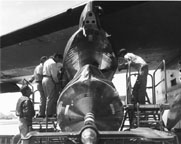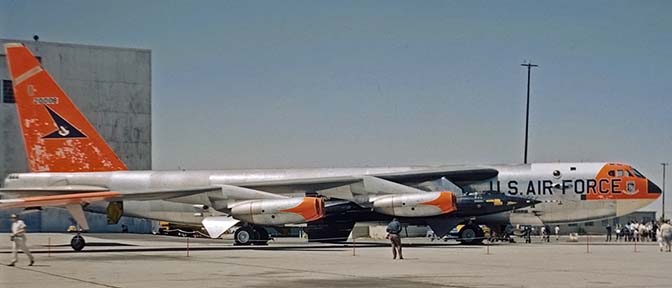

 The reaction control thrusters were first
installed in the X-15-2 in April 1960. Up to that time, the
highest altitude attained by the X-15 was 88,116 feet on mission
2-4-11, flown on February 11.
The reaction control thrusters were first
installed in the X-15-2 in April 1960. Up to that time, the
highest altitude attained by the X-15 was 88,116 feet on mission
2-4-11, flown on February 11.
Scott Crossfield first tested the reaction control thrusters in flight as the X-15-2 was carried by the NB-52A on May 5. On a typical X-15 flight, the reaction control thrusters would not be used until the X-15 had flown at high speed through the upper atmosphere. Air friction would have heated its airframe. At the launch altitude, the air temperature was well below freezing. The steam from the test of the nose reaction control thrusters froze immediately when it hit the windshield of the X-15. A thick layer of ice formed that obscured Crossfield's view out of the cockpit, forcing him to abort the intended launch.
A launch rehearsal was performed in place of the actual launch. During the procedure, one of the Auxiliary Power Units shut itself down. It was clear that considerable work would be necessary to get all of the X-15-2 systems operating at the same time. After landing at Edwards AFB, it was removed from the pylon of the NB-52A.
By the next morning, May 6, the X-15-1 had taken the place of the X-15-2 on the pylon of the NB-52A for Captain White's second familiarization flight.
 Joe Walker was launched in the
X-15-1 from the NB-52A on May 12, 1960 for the first mach-3 X-15
flight. (Link: NASA Dryden Biography) For the first time
the X-15 was carried away from Edwards AFB for a launch over
Silver Lake to allow it to make its speed run in a straight line.
Photo courtesy Edwards AFB History Office.
Joe Walker was launched in the
X-15-1 from the NB-52A on May 12, 1960 for the first mach-3 X-15
flight. (Link: NASA Dryden Biography) For the first time
the X-15 was carried away from Edwards AFB for a launch over
Silver Lake to allow it to make its speed run in a straight line.
Photo courtesy Edwards AFB History Office.
This photo has been used to illustrate the launch of the first Mach-3 X-15 flight on May 12, but in fact it was taken on the first powered flight of the X-15-1 on January 23. The yellow NASA tailband was retouched into the photo. The lettering is not proportioned properly and the font isn't right. After Crossfield made its first powered flight it was transferred to NASA and acquired the yellow tailband. It appears that NASA slipped up getting a photo of the launch of the Mach-3 flight and doctored an existing photo for the press release.
Walker reached mach 3.11 (2111 miles per hour) and an altitude of 77,882 feet. The value for the mach number was measured precisely, but the uncertainty in the conversion to absolute airspeed meant that it wasn't clear whether Walker had broken Mel Apt's speed record of mach 3.196 (2094 miles per hour), set in the X-2 on September 27, 1956. The launch pilots of the NB-52A were Captain Charles Bock and Major Jack Allavie.
 NB-52B 52-0008 was displayed with the X-15-1 56-6670 on
its pylon at the 1960 Edwards AFB Open House on May 17. Photo by
Richard Lockett Sr.
NB-52B 52-0008 was displayed with the X-15-1 56-6670 on
its pylon at the 1960 Edwards AFB Open House on May 17. Photo by
Richard Lockett Sr.
The "U. S. AIR FORCE" lettering on the fuselage of the NB-52B was initially 36 inches tall, compared to the 24 inch tall letters on the NB-52A. The scalloped dayglo on the engine nacelles lacks the white cheat line that was seen on the NB-52A in 1959. It can't be seen in this picture, but the flaps on the NB-52B were left unpainted while the starboard flaps on the NB-52A were painted white.
The orange dayglo paint on the tail can be seen to be peeling. By September 1960 it was removed, and a dayglo band was added to the rear fuselage. Later the dayglo on the engine intakes was also removed. Dayglo was used extensively on the aircraft operated from Edwards AFB in that era because orange wreckage is much easier to spot in the desert than aluminum, which tends to mirror the color of its surroundings.
 The X-15-2 was parked on the other
side of the NB-52B. Photo by W. Duncan via Dave Menard and Greg
Spahr.
The X-15-2 was parked on the other
side of the NB-52B. Photo by W. Duncan via Dave Menard and Greg
Spahr.
 The NB-52A made a fly-by of the airshow and
then taxied past the crowd along the flightline. Go to more
photos of the 1960 Edwards AFB Airshow.
Photo by Richard Lockett Sr.
The NB-52A made a fly-by of the airshow and
then taxied past the crowd along the flightline. Go to more
photos of the 1960 Edwards AFB Airshow.
Photo by Richard Lockett Sr.
Two days after the airshow, on May 19, the X-15-1 had been transferred to the wing of the NB-52A. Captain Robert White was launched by Major Allavie and Captain Bock on a flight that reached a speed of mach 2.31 (1590 miles per hour) and a new X-15 altitude record of 108,997 feet. It was the second highest flight in history. The altitude had been exceeded previously only by the 125,907 feet achieved by Ivan Kinchloe in the X-2 on September 7, 1956.
On May 26, Scott Crossfield was launched in the X-15-2 from the NB-52B for the first free flight test of the operation of the reaction control thrusters. The flight was only intended to demonstrate that the thrusters functioned properly. The maximum altitude attained on the flight was only 51,282 feet, so the thrusters actually had no effect on the attitude of the X-15. Once again Major Allavie piloted the NB-52B and Captain Bock served as co-pilot.
Joe Walker was carried aloft in the X-15-1 the following day, May 27, on what was to be the first of four attempts to make his fourth flight.
*The first position of the mission number identifies which X-15 was involved, the second number indicates how many times that X-15 had been launched, and the third number indicates how many times it had been carried by an NB-52.
Send a message to Brian
Go to home page of the Goleta Air & Space Museum.
Edited May 18, 2000.